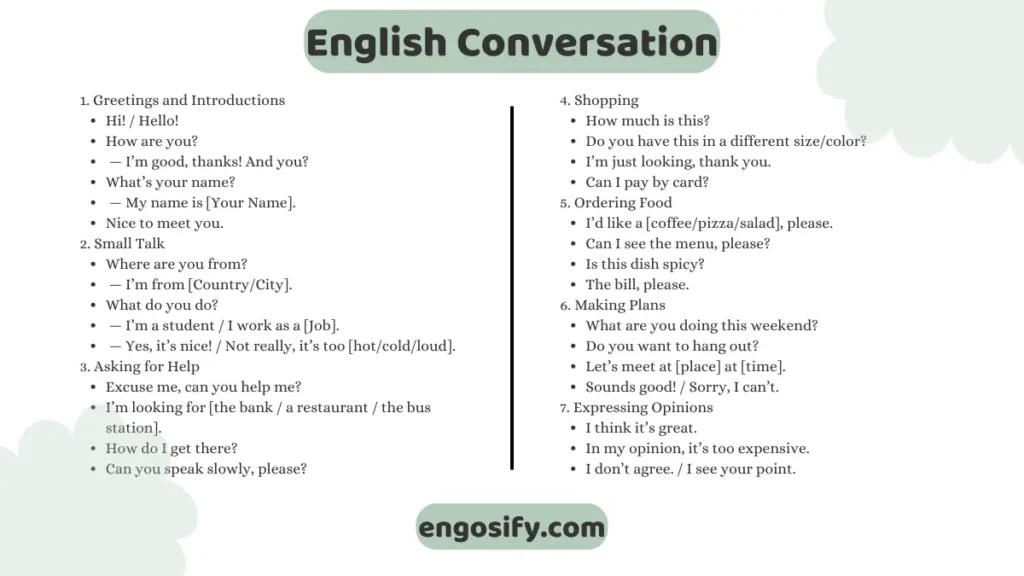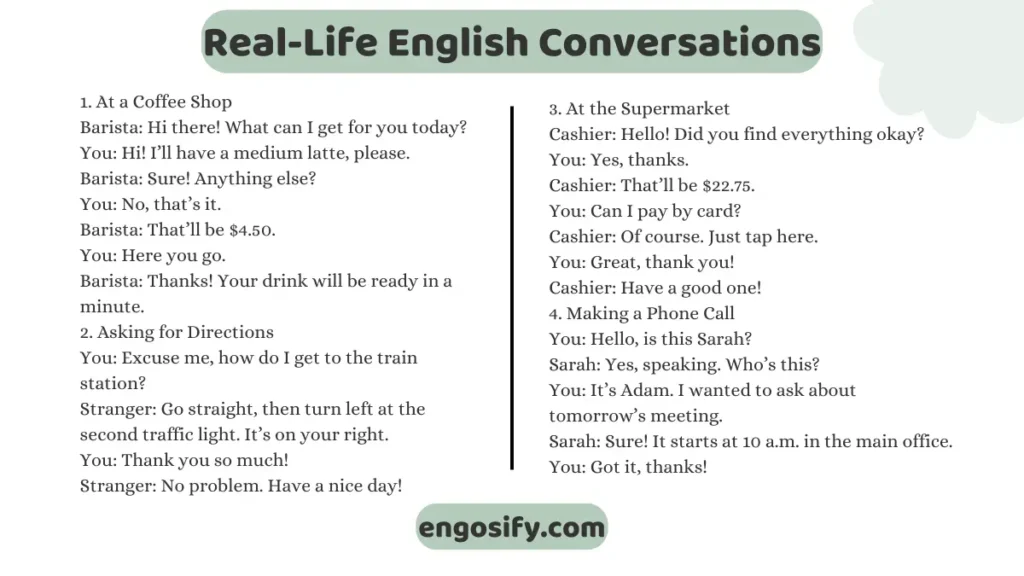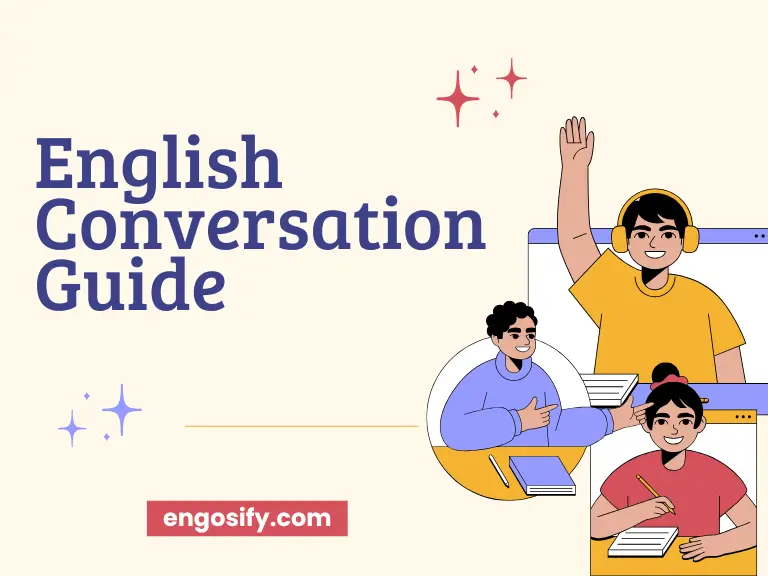Mastering Everyday English Conversations
Wanna speak English smoothly and naturally like it’s second nature? You’re in the right place! Whether you’re preparing for small talk at a café, chatting with colleagues, or handling daily errands, having strong conversational English skills makes life a whole lot easier.
This English Conversation Guide is your go-to roadmap for becoming more confident, fluent, and expressive in everyday situations. We’ll cover how to start and maintain chats, what topics are safe bets, and even how to handle cultural nuances like a pro. Plus, we’ll sprinkle in some practical phrases, real-life examples, and tips that’ll make you sound more like a native speaker than a textbook.
Let’s dive right into the first step—starting a conversation.
Breaking the Ice – Initiating Conversations
Common Greetings and Introductions
Starting a conversation can be nerve-wracking, especially if English isn’t your first language. But hey, the good news is that most conversations begin with simple greetings and small talk. You don’t need to be Shakespeare—just be friendly and clear.
Here are some solid openers:
- “Hi! How’s it going?”
- “Good morning! I’m Alex. What’s your name?”
- “Hey there! Do you come here often?”
The key is to adjust your tone based on the setting. In formal situations like business meetings, stick to polite and clear greetings:
“Good afternoon. My name is Maya. It’s nice to meet you.”
For casual hangouts or when meeting someone at a coffee shop:
“Hey! I’m Tom. Mind if I join you?”
These introductory phrases help break the ice and signal you’re open to conversation.
Effective Ice-Breakers
Let’s be real—awkward silences are the worst. So, when you’ve said “hi,” what next? Ice-breakers are your secret weapon.
Here are a few simple but powerful go-to lines:
- “I love your accent—where are you from?”
- “This place has great coffee, doesn’t it?”
- “Crazy weather today, huh?”
Notice how these questions are open-ended, friendly, and invite the other person to respond. They also show interest, which makes people more likely to open up.
If you’re still unsure how to kick things off, check out EF English Live’s starter tips—they’re loaded with practical ways to spark chats.
Keep it relaxed, smile, and let your natural curiosity do the rest.
Keeping It Flowing – Sustaining Conversations Naturally
Active Listening: The Secret Ingredient
You know what? Talking is only half the battle. If you want to sound natural and connect better, you’ve got to be a good listener too. That’s where active listening comes into play.
So, what does that even mean?
It means:
- Nodding and showing interest
- Using short phrases like “Really?”, “That’s interesting”, or “No way!”
- Asking questions based on what they say
For example:
A: “I went hiking last weekend.”
B: “Oh nice! Where’d you go? Was the trail tough?”
Boom—you’ve just extended the conversation like a pro.
Using active listening shows respect, curiosity, and attention. And bonus—it gives you more time to think about what to say next!

Asking the Right Questions
If you’re wondering what to ask, here’s a simple trick—use the 5W+1H rule:
- What do you do?
- Where are you from?
- When did you move here?
- Why do you like that hobby?
- Who do you usually go with?
- How long have you lived here?
These types of questions invite conversation, not just a “yes” or “no.” They also help you learn more about someone while keeping the chat flowing effortlessly.
You could say something like:
- “What do you usually do on weekends?”
- “How did you get into photography?”
Just make sure to avoid interrogating them like a detective—keep it chill and friendly.
Phrases That Keep the Chat Rolling
Sometimes, you just need a few ready-to-go lines to keep things smooth. Here are a few golden phrases to slip in when the conversation starts dipping:
- “That reminds me of…”
- “Speaking of that, have you ever…?”
- “You know what’s funny?”
These transitions keep the energy going and make the chat feel more natural—just like how native speakers talk!
Wanna hear how real people do it? BBC Learning English has audio examples of everyday conversations worth checking out.
Everyday English Conversations – Real-Life Situations You’ll Actually Use
Let’s be real: textbook English doesn’t always help when you’re ordering lunch or asking for directions. That’s why we’re diving into practical English phrases that you can use in everyday life. These are must-know expressions that help you sound confident and natural—just like a native speaker.
Shopping and Asking for Help
Whether you’re browsing clothes or hunting for tech gadgets, here’s what you might hear—and say:
Useful Phrases:
- “Excuse me, do you have this in a different size?”
- “I’m just looking, thanks!”
- “How much does this cost?”
- “Can I try this on?”
And if you need assistance:
- “Could you help me find the jeans section?”
- “Do you offer any discounts?”
See how simple and effective that is? You don’t need long, fancy words. You just need clear, polite phrases that show you know what you’re doing.
Ordering Food and Drinks
Let’s face it—menus can be intimidating, especially with unfamiliar dishes. But once you’ve got a few key expressions under your belt, you’ll feel at home in any café or restaurant.
Try saying:
- “Can I get a coffee to go, please?”
- “What do you recommend?”
- “I’d like the grilled chicken sandwich.”
- “Can I have the bill, please?”
And don’t forget the classic:
- “Could I have that without onions?”
It’s all about being polite yet clear. Practice these with a friend or even at home with a pretend menu.
Getting Around: Directions & Travel
Need to ask for directions? Or take a cab? Here’s what you’ll want in your back pocket:
Asking for directions:
- “Excuse me, how do I get to the train station?”
- “Is this the right way to the museum?”
- “Can you show me on the map?”
In a taxi:
- “Could you take me to Main Street, please?”
- “How long will it take?”
- “Can we stop here?”
To level up, check out this awesome interactive travel phrase guide from Cambridge.
Sounding Natural – Pronunciation, Intonation & Fluency Hacks
So, you’ve got the words. You’ve got the phrases. But something still feels a little… off? That’s likely because you’re missing the rhythm of natural speech. If your goal is to speak English smoothly and confidently, this section is your game-changer.
Why Pronunciation Matters More Than You Think
Let’s clear one thing up: You don’t need a perfect American or British accent. Not at all. But being understood clearly? That’s essential.
Here are some common pronunciation struggles:
- Mixing up “ship” and “sheep”
- Saying “three” as “tree”
- Forgetting word stress in “present” (noun vs. verb)
Use tools like Forvo to hear how native speakers pronounce tricky words. You can even repeat and record yourself—instant feedback!
Mastering Intonation and Sentence Stress
English isn’t a flat language. It’s full of ups and downs—intonation! The way your voice rises and falls can completely change the meaning of what you’re saying.
For example:
- “You’re going?” (a neutral question)
- “You’re going?” (surprised!)
- “You’re going?” (maybe they expected someone else to go)
Practice by reading short dialogues out loud, focusing on the rise and fall of the voice. You can even copy your favorite TV show scenes—yes, mimicking works!
Linking Words and Speaking Fluidly
Native speakers don’t pause between every word. They link words together:
- “What do you want to do?” sounds more like “Whaddaya wanna do?”
- “I’m going to go” becomes “I’m gonna go”
Don’t panic—this doesn’t mean being sloppy. It means being natural. If you want to get comfortable with this, check out Rachel’s English for bite-sized tutorials on connected speech.
Bonus Hack: Think in English
Here’s a golden tip—think in English. If you’re constantly translating from your native language, you’ll always lag behind. Start small:
- Name items around your house in English.
- Narrate your actions out loud: “Now I’m brushing my teeth.”
- Ask yourself questions in English like “What should I eat today?”
Over time, your brain will rewire itself to function in English. That’s fluency gold.
The Power of Non-Verbal Communication & Confidence
Alright—so your vocabulary’s growing, your pronunciation’s improving, and your fluency is flowing. But what if I told you how you say something can be just as important as what you say?
Yep, body language and confidence are like secret weapons in any English conversation guide.
Body Language: Speak Without Saying a Word
Did you know that more than 50% of communication is non-verbal? That means your facial expressions, hand gestures, eye contact, and even your posture can completely change how others perceive your words.
Here’s how to use body language to your advantage:
- Smile when greeting or agreeing—shows friendliness.
- Nod while listening—it signals engagement.
- Use your hands when explaining something complex—don’t be afraid to animate!
- Maintain eye contact, but don’t stare—aim for balance.
In everyday English conversations, your gestures help emphasize what you’re saying, especially if you’re still growing your vocabulary.
Boosting Confidence—Even If You’re Still Learning
Confidence doesn’t mean knowing every word—it means being okay not knowing, and handling it smoothly.
Try these quick tricks to level up your confidence:
- Use filler phrases like:
- “Let me think for a second…”
- “That’s a great question!”
- “I’m not sure how to say it, but…”
These give you time to organize your thoughts without awkward silence.
- Practice speaking aloud daily, even if it’s just to yourself. Repetition builds fluency and confidence at the same time.
- Celebrate small wins—did you order coffee in English today? Nice. Did you chat with someone for 2 minutes? That’s progress!
Oh—and if you’re feeling shy, remind yourself: Most people are happy you’re trying. They’re not judging you.
Use Tech to Practice with Confidence
Record yourself using your phone, then play it back. It may feel weird at first, but it helps you hear your rhythm, pronunciation, and energy. You’ll catch things you didn’t even notice while speaking!
You can also try language exchange apps like HelloTalk where native speakers help you in real time—and you help them too. It’s a win-win!
Real-Life English Conversations You Can Practice Daily
Now that you’ve got the tools—vocabulary, grammar, confidence, and body language—let’s put it all together. Practicing real-life English conversations is where the magic happens.
In this part, we’ll dive into everyday scenarios you face all the time and show you exactly how to handle them like a pro.
At the Store or Market
Let’s say you’re shopping for snacks. Here’s a simple, natural dialogue you can mimic:
You: “Hi, do you have any fresh bread today?”
Shopkeeper: “Yes, it’s right over there on the shelf.”
You: “Great, I’ll take two loaves, please.”
Shopkeeper: “Sure thing. Anything else?”
You: “That’s all for now, thanks!”
Tip: Use polite phrases like “Do you have…”, “I’ll take…”, and “That’s all”—they sound natural and friendly.
Ordering at a Café
Master this situation and you’ll feel like a native!
You: “Hi, can I get a cappuccino to go?”
Barista: “Of course. What size?”
You: “Medium, please.”
Barista: “Anything else?”
You: “No, that’s it. Thank you!”
Using phrases like “to go” and “that’s it” boosts your fluency and shows your understanding of casual English.
Talking on the Phone
Phone calls can be tricky because you lose body language cues. But here’s a simple script:
You: “Hi, this is Emma. I’m calling to confirm my appointment.”
Receptionist: “Hi Emma. Yes, your appointment is at 3 PM tomorrow.”
You: “Perfect, thank you. See you then!”

Practicing with voice apps or even reading these aloud improves your listening comprehension too!
Making Small Talk
Small talk might feel silly, but it’s a huge part of speaking natural English. Try this at a party or with coworkers:
You: “Hi, I’m Alex. Nice to meet you!”
Them: “Nice to meet you too! How do you know everyone here?”
You: “Oh, I work with Sarah. We’re on the same team.”
Them: “Cool! What do you do?”
Boom—you’re in the flow of conversation.
💬 Use simple openers like “So, what brings you here?”, “How’s your day going?”, or “Is this your first time here?”
Practice Makes Fluent
These short dialogues may seem basic, but they’re practical. They mirror real-world interactions that help you build confidence and think in English.
Also, try role-playing these scenarios with a friend or tutor, or record yourself playing both parts. Yep, you’ll feel silly—but it works!
Staying Consistent and Making English a Habit
So, you’ve come a long way—from understanding grammar basics to practicing real-life conversations. But let’s be real: progress doesn’t stick unless you stay consistent. Now, we’ll show you how to make English a natural part of your daily life without burning out or getting bored.
Set a Routine You Can Stick To
You don’t need to study for hours. Instead, aim for 15–30 minutes daily. That’s enough to keep your brain actively engaged with the language. Here’s a simple plan:
- Morning: Listen to a short podcast during breakfast.
- Afternoon: Read a short blog post or social media thread in English.
- Evening: Practice speaking or journaling for 10 minutes.
Consistency beats intensity every time.
Make English Automatic
Want to start thinking in English? Surround yourself with the language:
- Change your phone’s language to English.
- Watch YouTube videos or Netflix with English subtitles.
- Label household items in English (yes, sticky notes work wonders!).
The goal is immersion—without leaving your house.
Use Apps and Tools to Track Progress
Let’s be honest, tracking your growth keeps you motivated. Use language-learning apps like:
- Duolingo or Memrise for vocab building
- HelloTalk or Tandem to chat with native speakers
- Anki or Quizlet for flashcard review
Set reminders, streak goals, or mini-challenges to stay pumped!
Join Speaking Clubs or Language Meetups
It’s one thing to talk to yourself—but real interaction builds true fluency. Join online conversation clubs, local language meetups, or even virtual cafés.
Don’t know where to start? Check out this helpful guide on how to find English speaking partners and connect with learners around the world.
It’s a safe space to make mistakes, learn naturally, and boost your confidence.
Remember: It’s a Marathon, Not a Sprint
Fluency doesn’t happen overnight, but with daily effort and the right mindset, you will get there. Celebrate the small wins—like ordering food or having a 5-minute conversation—and keep leveling up from there.
And hey, even native speakers mess up sometimes. So give yourself some grace, laugh at the hiccups, and keep going!
FAQs
1. How can I improve my English conversation skills quickly?
To boost your English speaking skills fast, practice consistently by speaking with native speakers, using language apps, and immersing yourself in English media like podcasts, videos, or books. Even 15 minutes a day can make a huge difference over time.
2. What are some common English phrases for daily conversations?
Some useful daily English phrases include:
- “How’s it going?”
- “What do you do for a living?”
- “Could you help me with this?”
- “That sounds great!”
- “Let me think about it.”
These phrases help you sound more natural in real-life situations.
3. How can I speak English fluently without hesitation?
Fluency comes from confidence and muscle memory. Practice speaking out loud daily, think in English, and don’t worry about making mistakes. The more you speak, the less you’ll hesitate.
4. Are grammar rules important in conversation?
Yes—but not at the expense of communication. Focus on clear and natural expression. Understanding grammar helps, but fluency comes from speaking regularly and learning from context.
5. Can watching movies and listening to music help improve my spoken English?
Absolutely! Movies, music, and shows expose you to native expressions, intonation, and casual vocabulary. They’re also fun, so you’ll stay motivated and pick up conversational English effortlessly.
6. How do I expand my vocabulary for conversations?
Read regularly, use flashcards (like Anki or Quizlet), and jot down new words in a notebook. But most importantly, use them in daily conversations so they stick.
Conclusion
Mastering English conversation is an exciting and achievable goal, whether you’re just starting out or looking to enhance your fluency. By focusing on the right strategies, practicing consistently, and staying patient with your progress, you’ll find yourself confidently navigating conversations in no time.
Remember, it’s not just about memorizing words or phrases—it’s about making the language part of your daily life. With the tips and techniques shared in this guide, you’ll be well-equipped to engage in natural, effective conversations with native speakers and fellow learners.
So, keep practicing, stay curious, and don’t be afraid to make mistakes. Each conversation is a step toward mastering English and building a genuine connection with others. Happy speaking!

